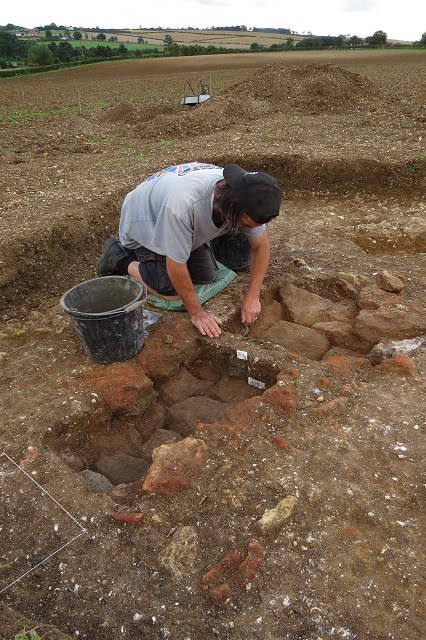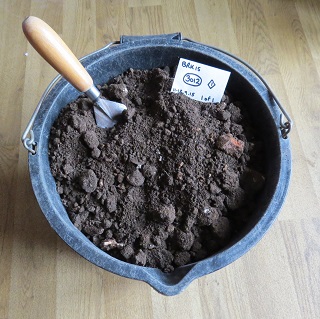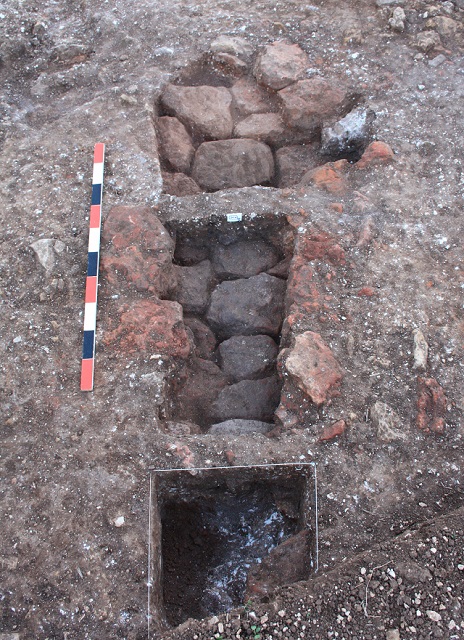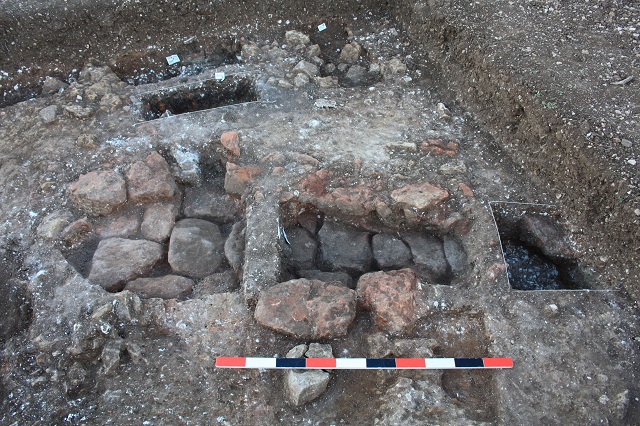At Trench C Jonathan has been busy with the feature we thought, following the trowelling clean of the top of the archaeological remains, was likely to be a Roman corn-dryer (see earlier posting, Day 5). His careful excavation work on this feature has proved that our guess was well-founded. The surface clue was a keyhole shaped arrangement of stones with a soil filling. These dryers have a flue channel where there would have been a small fire; this is fed from a stoke hole at one end and the opposite end will be where the heated air, a little away from the main heat source, will have risen to parch cereal grains on a platform (see posting of Day 5 for the reasons for this process). The photos show that this dryer had been constructed from stone blocks. Its shape is fairly well preserved but only the bottom of the feature survives as its upper part has been truncated by (doubtless several) processes that have occurred in the area of the site since the Roman period, most recently routine agricultural ploughing. Here most of the lower course of stones survive; in places though a few are missing.
The stone used to make the structure is Claxby Ironstone; that was evidently the main stone used too for the walls of the Roman buildings at the site. Perhaps it is significant that there are no re-used Roman ceramic tiles or bricks in the structure. In this case most of the ironstone blocks have turned from their normal brownish-yellow to a red colour, this might be due to the temperature or a chemical change triggered by the heating and exposure. The walls of one of the corn-dryers excavated at Hatcliffe a few seasons ago as part of the wider project had stone walls, but the stone floor to this one shows considerable care taken in what will have been a temporary ’work-a-day’ heating oven not intended to be other than functional. Jonathan removed an upper fill of soil and fortunately he found that the lower level comprised soot, ash, fragments of fired clay and a dark soil; these will be a remains from when the dryer was used.
The photos indicate this sooty ash covering on the floor of the dryer. Finding this is great news as this debris, is, according to Steve, exactly what we are hoping to find on the dig. The reason being that it should contain burnt grains that by chance slipped through the parching floor and will be preserved as charcoal, as well as fragments of the fuel used (?coal, straw, twigs).
So we kept this lower soil and the photo here shows some of it in a bucket. It will be analysed by the expert James Rackham and his team who will see what grains and other fragments are there which will tell us the details of the economy of the site and the environment around it, agricultural and natural, in Roman times. This is the first such dryer we have found at the Binbrook site. However, there is every indication this one overlies an earlier one – so we may have a sequence of dryers. Good news!
We will plan this feature next: that is make a scale drawing of its details. A feature like this is excellent for training students in recording methods. Jonathan will turn from use of the trowel to sharpening his pencil.
On the other side of Trench C the wall foundation is being cleaned and defined. It is represented by an alignment of stone rubble. The unstructured nature of the rubble makes us wonder if this is the debris from the wall being ‘robbed’ of its best stone long ago and the debris thrown-back. The shape of the construction cut for the foundations is, though, well-persevered and we are speculating if gritty patches are decayed Roman mortar. We wonder at the moment whether the dryers date to after the time when this stone building went out of use.
The martins are gathering in the sky to begin to fly south and the weather is on the turn from the dry and sunny conditions we have enjoyed over the past few days. Alan, our volunteer expert digger, plants indigenous trees on the Wolds each autumn, including species with fruits suitable for resident and migratory birds. One of the aims of the project is the recovery of evidence for the environment in the Waithe valley in past times. Little is known of the ecology of the Wolds in prehistory and the Roman era. The University of Sheffield collected important environmental data in the early 1980s when they looked at the long barrows in this part of the Wolds. Our published volume (2013) covering the site at Nettleton/Rothwell Top included much new data. The evidence from the corn-dryer(s) and ancient pollen samples from the Binbrook site hold much potential.
The Dig Team




